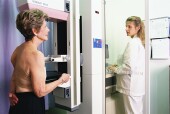
TUESDAY, Aug. 5, 2014 (HealthDay News) — Women 75 and older may still benefit from routine mammograms, according to new research.
However, not everyone agrees with this study’s conclusions.
“Mammography detects breast cancer early, when it’s more treatable and the risk of death is very low,” said study researcher Judith Malmgren, an affiliate assistant professor at the University of Washington School of Public Health and Community Medicine, Seattle.
“If it’s not detected by a mammogram and it’s detected by the physician or the patients, women are more likely to have advanced stage disease and there is a higher risk of death,” she said.
The study findings do make an important argument that age alone is not a reason to abandon mammography, said Dr. Gerrit-Jan Liefers, a surgical oncologist at Leiden University Medical Center in the Netherlands. Liefers was not involved with the current research, but he did review the study’s findings.
But, he added, the findings don’t convince him that older women need routine screening.
In fact, Liefers presented preliminary findings from a study he conducted that found mammograms in women 70 and older might do more harm than good at the European Breast Cancer Conference earlier this year. He found that the screenings don’t decrease the number of advanced breast cancer cases, but do lead to ”overtreatment,” putting some at risk of harmful side effects.
Guidelines from professional organizations don’t agree on routine mammograms for older women either. The American Cancer Society recommends that women continue to have mammograms annually as long as they remain in good health.
However, the U.S. Preventive Services Task Force, an independent panel of experts in prevention and evidence-based medicine, concludes that there is not enough evidence one way or the other to recommend routine screening for women 75 and older.
The study was published online Aug. 5 in Radiology
In the new study, Malmgren and her colleagues looked at data from a registry of women with breast cancer. They found more than 1,100 women over age 75 diagnosed with early- to late-stage breast cancer from 1990 to 2011.
The registry had information on how the cancer was diagnosed, the stage and other data. The detection of cancers with mammography increased over time during the study, from 49 percent to 70 percent.
Most mammography-detected cancers were in the early stage, while those found by doctors and patients were more likely to be advanced.
Those detected by mammography were more likely to need less aggressive treatments as well.
The study said that breast cancer survival was better in women whose cancer was detected by mammography, with 97 percent alive five years later. In comparison, 87 percent of those with invasive cancers found by their doctor or themselves were alive at the five-year mark.
However, the study was only able to show a link between mammography and improved survival. It wasn’t able to prove that mammography was directly linked to the increased survival.
In addition, Liefers argued that the conclusion that fewer women died of breast cancer if it was detected by mammography may not be accurate. Other factors may play in to the survival besides the screening itself, he said. For instance, patient-detected tumors may be more aggressive than mammography-detected tumors.
Findings that do favor screening for older women include the decrease in advanced cancers and the increase in early cancer detection, Liefers said.
The take-home message, according to Malmgren, is for women 75 and over to get a mammogram every other year. That advice only holds true if women have a life expectancy of five years or more, though.
Liefers said that women should ”discuss their individual risk of breast cancer and competing risks of mortality with their doctor,” before making a decision on whether or not to get a mammogram.
More information
To learn more about early detection of cancer, visit American Cancer Society.
Copyright © 2025 HealthDay. All rights reserved.

